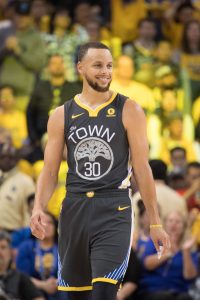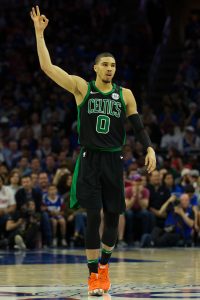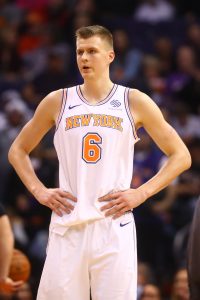While many of the NBA’s highest-paid players are on contracts considered maximum-salary deals, the 2018/19 salaries for those players vary significantly depending on when the player signed his contract and how much NBA experience he has. That’s why a player like Stephen Curry can earn $17MM+ more than Kyrie Irving in ’18/19 despite both star point guards technically being on max deals.
When a player signs a maximum-salary contract, he doesn’t necessarily earn the NBA max for each season of that contract — he earns the max in year one, then gets a series of identical annual raises. In Curry’s case, his 2018/19 salary actually exceeds this year’s maximum, since his deal started last summer and includes 8% annual raises, while the cap only rose by about 3% this season.
Listed below, with the help of salary data from Eric Pincus of Basketball Insiders, are the top 50 highest-paid NBA players for the 2017/18 season. The players on this list don’t necessarily have the contracts with the largest overall value. Jabari Parker‘s $20MM salary, for instance, places him among the highest-paid players for this season, but the total value of his deal is modest, since it’s only guaranteed for one year, with a second-year option. The list below only considers salaries for 2018/19.
Additionally, we’ve noted players who could potentially increase their earnings via incentives or trade bonuses. We didn’t add those notes for players like Curry, LeBron James, and others who have trade bonuses but are already earning the maximum — their salaries for this season can’t increase beyond their max.
Here are the NBA’s 50 highest-paid players for the 2018/19 season:
- Stephen Curry, Warriors: $37,457,154
- LeBron James, Lakers: $35,654,150
- Chris Paul, Rockets: $35,654,150
- Russell Westbrook, Thunder: $35,654,150
- Blake Griffin, Pistons: $32,088,932
- Gordon Hayward, Celtics: $31,214,295
- Kyle Lowry, Raptors: $31,200,000 (plus incentives)
- Paul George, Thunder: $30,560,700
- Mike Conley, Grizzlies: $30,521,116
- James Harden, Rockets: $30,421,854 (15% trade kicker)
- Kevin Durant, Warriors: $30,000,000 (15% trade kicker)
- Paul Millsap, Nuggets: $29,230,769 (plus incentives)
- Al Horford, Celtics: $28,928,710 (15% trade kicker)
- Damian Lillard, Trail Blazers: $27,977,689
- DeMar DeRozan, Spurs: $27,739,975
- Otto Porter, Wizards: $26,011,913
- Jrue Holiday, Pelicans: $25,976,111 (plus incentives)
- C.J. McCollum, Trail Blazers: $25,759,766
- Joel Embiid, Sixers: $25,467,250
- Andrew Wiggins, Timberwolves: $25,467,250
- Andre Drummond, Pistons: $25,434,263 (8% trade kicker)
- Hassan Whiteside, Heat: $25,434,263
- Bradley Beal, Wizards: $25,434,262
- Anthony Davis, Pelicans: $25,434,262
- Nikola Jokic, Nuggets: $24,605,181 (plus incentives)
- Steven Adams, Thunder: $24,157,304 (7.5% trade kicker)
- Giannis Antetokounmpo, Bucks: $24,157,304
- Marc Gasol, Grizzlies: $24,119,025 (15% trade kicker)
- Kevin Love, Cavaliers: $24,119,025
- Harrison Barnes, Mavericks: $24,107,258 (8% trade kicker)
- Chandler Parsons, Grizzlies: $24,107,258
- Nicolas Batum, Hornets: $24,000,000
- Rudy Gobert, Jazz: $23,241,573 (plus incentives)
- Kawhi Leonard, Raptors: $23,114,067
- DeAndre Jordan, Mavericks: $22,897,200
- LaMarcus Aldridge, Spurs: $22,347,015 (15% trade kicker)
- Serge Ibaka, Raptors: $21,666,667
- Aaron Gordon, Magic: $21,590,909 (plus incentives)
- Danilo Gallinari, Clippers: $21,587,579
- Victor Oladipo, Pacers: $21,000,000
- Jimmy Butler, Timberwolves: $20,445,779
- Ryan Anderson, Suns: $20,421,546
- Kyrie Irving, Celtics: $20,099,189
- Jabari Parker, Bulls: $20,000,000
- Zach LaVine, Bulls: $19,500,000
- Tyler Johnson, Heat: $19,245,370
- John Wall, Wizards: $19,169,800
- George Hill, Cavaliers: $19,000,000
- Jeff Teague, Timberwolves: $19,000,000
- Klay Thompson, Warriors: $18,988,725
Note: Some outlets suggest Anthony Davis has a 15% trade kicker, but it’s not listed on Basketball Insiders.
Note: Carmelo Anthony is not included on this list because his $25,534,253 buyout with the Hawks will be paid over three seasons, even though Atlanta kept the entire cap hit on this year’s team salary. If included, he would come in at No. 15, since his Hawks buyout plus his Rockets salary totals $27,928,140.
Photo courtesy of USA Today Sports Images.


 Why the Knicks should give him an extension:
Why the Knicks should give him an extension:
 Why the Timberwolves should give him an extension:
Why the Timberwolves should give him an extension: